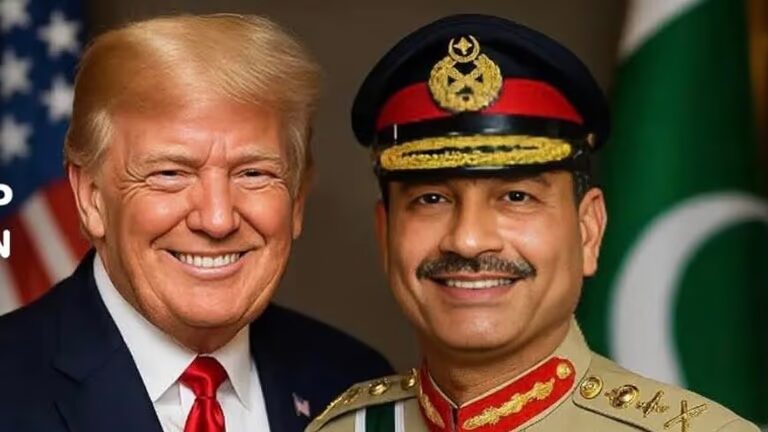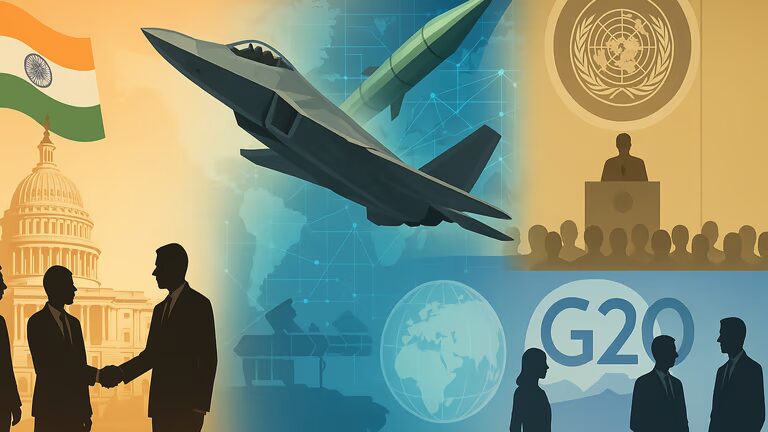
In 2025, US-Pakistan ties seemed to have rekindled the diplomatic circles, an impending concern to India. From military partnerships and economic aid to symbolic gestures like high-profile visits, developments raised an important question: Should India worry about this recalibrated relationship between Washington and Islamabad?
Here we will examine the historical background, military dimensions, strategic implications, and the policy response from India-an essential reading for civil service candidates and international relations lovers.
ALSO READ- Bharat Bandh on 9 July 2025
Background: An Alliance Spanning a Decade-
- The US-Pakistan relationship is strategic and often transactional since the Cold War.
- A frontline ally of the Soviets within the Afghan conflict during the 1980s became Pakistan.
- Pakistan was openly an ally in the war on terror, receiving billions in aid.
- In the 2010s, relations began to worsen with a growing trust deficit when Abbottabad became synonymous with Osama bin Laden’s presence and drone strikes became an obvious act against Pakistan.
Tie-Ups and Agreements between the US and Pakistan-
Important Treaties and Agreements:
- SEATO and CENTO: Provided early bases for military cooperation.
- These pacts allowed Pakistan to receive considerable military hardware from the US.
- Pakistan was to offer itself as a strategic counterweight to Soviet influence in South Asia.
- This was what made Western acknowledgement of Pakistan as an ally during the Cold War.
- The United States has put in billions of dollars’ worth of investments in Pakistan, but it has also been the most notable critic of Pakistan concerning its counter-terrorism policies.
- It establishes continuity for bilateral discussions across administrations within this revived format.
- The focus is on regional stability through enhanced defence and trade engagements.
- Discussion on nuclear non-proliferation and anti-radicalisation efforts has remained on the dockets of the dialogue.
New Initiatives (2023-2025):
- Joint Counter-Terrorism Practice.
- This mainly has urban warfare, counter-IED, and hostage rescue operations.
- It was organised every year to enable tactical interoperability between US and Pakistani forces.
- India fears the potential of these operations for a wider defence collaboration.
Cyberspace and Intelligence-Sharing Pact (2024):
- Cooperation in critical infrastructure security, besides digital surveillance systems.
- Provides a framework for getting real-time information on dynamic terror threats in the region.
- Raises concerns in India about access by Pakistan to advanced cyber tools and their likely misuse.
US Support for Building Pakistani Green Infrastructure Loans through the World Bank:
- Aims to bring the energy sector and the transport sector of Pakistan into the fold of climate change measures.
- It is used to facilitate access to low-interest loans and green technology partnerships for Pakistan.
- What is assumed to be environment-friendly really does raise fears in India that it may open up more budgetary space to expand military resources.
US Aids to Pakistan: The Taxpayer Load-
US aid to Pakistan continues despite domestic pushback, albeit under scrutiny.
- Aid over $40 billion since 1947 (civil + military).
- From 2022-2025, a total of $1.2 billion has been offered in counter-terrorism and humanitarian aid.
- Funds channelled via USAID, IMF, and defence transfers.
- Critics charge that the past misuse of funds may be indirectly supporting anti-India terror groups.
Asif Munir’s US Visit: Dinner or Diplomacy?
May 2025 will witness the attendance of General Asif Munir of Pakistan at an exclusive diplomatic dinner organised by the White House-a rare honour indeed for a foreign dignitary.

Symbolism:
Enduringly indicative of the military importance with which Pakistan invests in diplomatic channels.
The backtrack has created some speculation for backdoor negotiations on Afghanistan, China, and Iran.
Indian Response:
The rather contained reaction came from the Ministry of External Affairs in terms of reaffirming the faith that India and America would continue to share.
Indian think tanks made calls for deeper engagement with the United States Congress and the Diaspora.
Trump and Nobel Peace Prize Buzz-
Recently, Pakistani Army Chief Asim Munir and Israeli PM Netanyahu nominated President Donald Trump for the Nobel Peace Prize.
According to Pakistan, he played a role in helping to negotiate a ceasefire between India and Pakistan at the time of Operation Sindoor. However, India denied this claim and said that we don’t want any diplomatic intervention from a third party.
Should India be worried?
India’s Worrying Dimensions:
- Strategic encirclement: Renewed US-Pakistan ties, becoming stronger with the China-Pakistan Axis, lead to two-front war concerns.
- Terror Tolerance: Pakistan’s shady record about terror groups keeps worrying New Delhi.
- Aid Misuse: Indian analysts fear that American arms and funds could get diverted to proxy groups.
Counterbalances in India’s Favour:
- India-US Strategic Partnership: QUAD, 2+2 Dialogue, BECA Agreement.
- Defence Collaboration: Recent India-US jet engine tech transfer agreement and UAV cooperation.
- Global Standing: India’s economic clout and soft power far outnumber Pakistan’s influence.
India’s Policy Responses:
- Diplomatic Approach: Establishing good relations with the US Congress, American think-tanks, and the Indian-American diaspora.
- Drawing international attention, like FATF and UNGA, to the double standards of Pakistan on terror.
Defence & Strategic Focus:
- Faster AMCA and indigenous missile programs.
- Accelerated focus on border digitisation, cyber defence, and AI-enabled surveillance.
Economic Diplomacy:
- Highlighting India as a dependable partner in technology and defence for the West.
- Hosting G20 follow-up economic summits to reaffirm India’s global leadership.

Conclusion: Remain Vigilant, Not Paranoid.
Due to shortcomings found in the F35 fighter jet globally, India expressed its reluctance to buy it. This could possibly be a reason for India-US relations worsening and US-Pakistan relations coming closer.
Though one could speak of changing US-Pakistan relations, by now India’s dominance as a global power is much stronger in 2025 than it had been in any given previous decade.
New Delhi should be watchful but not hyper-reactive; in the long run, strategic maturity arising from long-term interests would benefit India much more than raising an alarm.
FAQs-
India remained diplomatically restrained in reiterating the strength of India–US ties.
There was no mediation.
Mostly for counter-terrorism, humanitarian support, and very limited maintenance of military hardware.
Yes, but they will be limited and closely monitored under extremely stringent end-use assurances.
